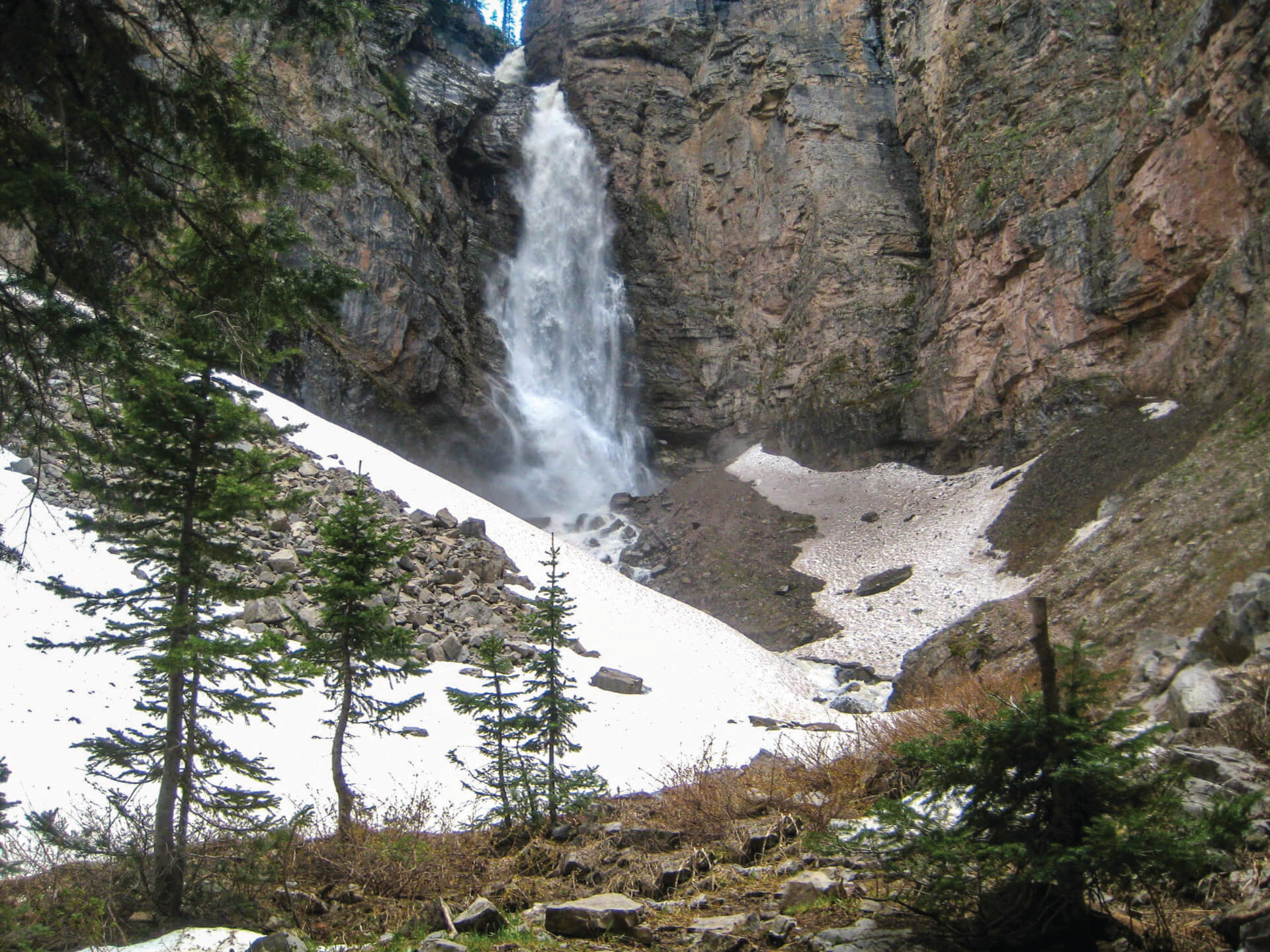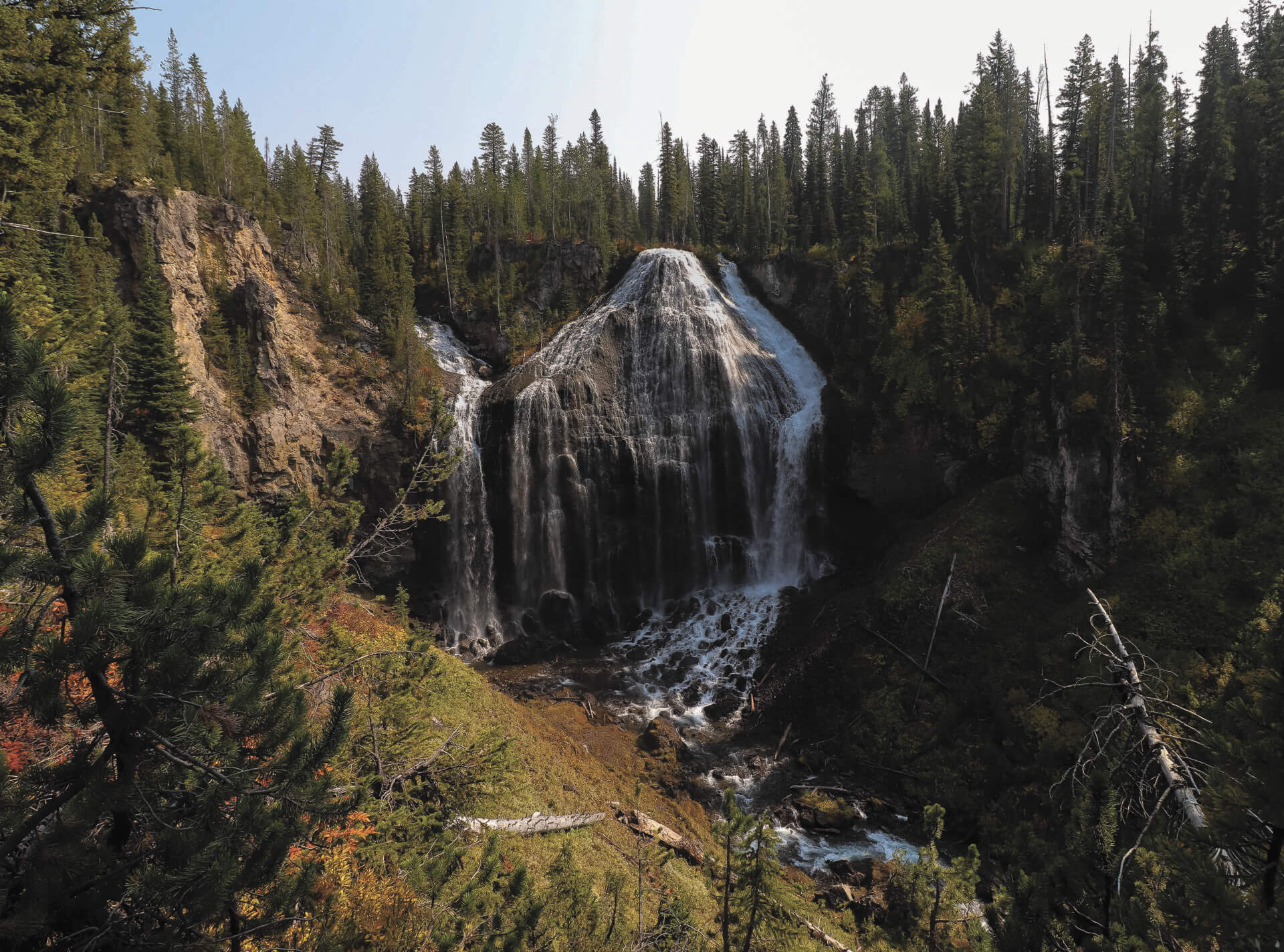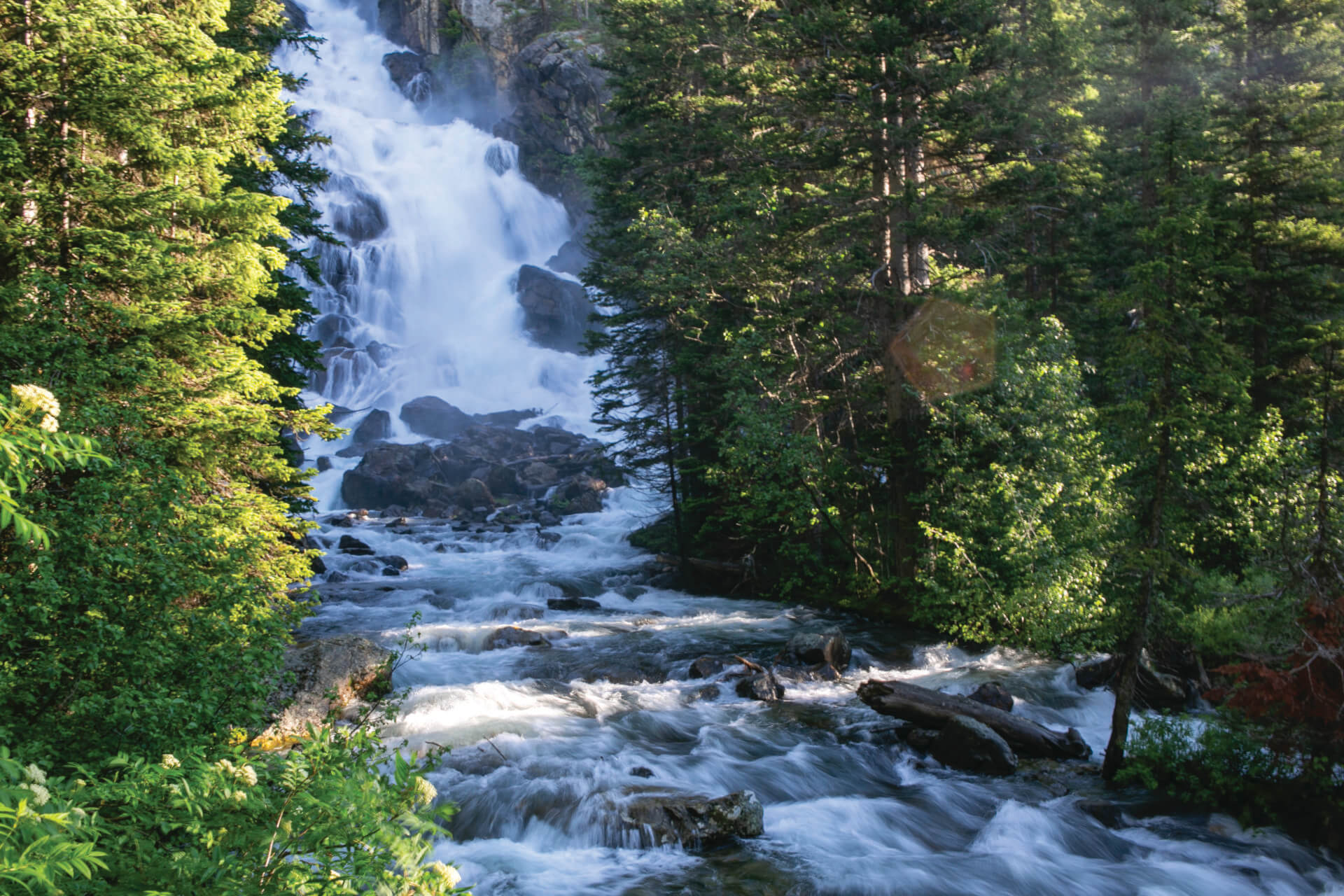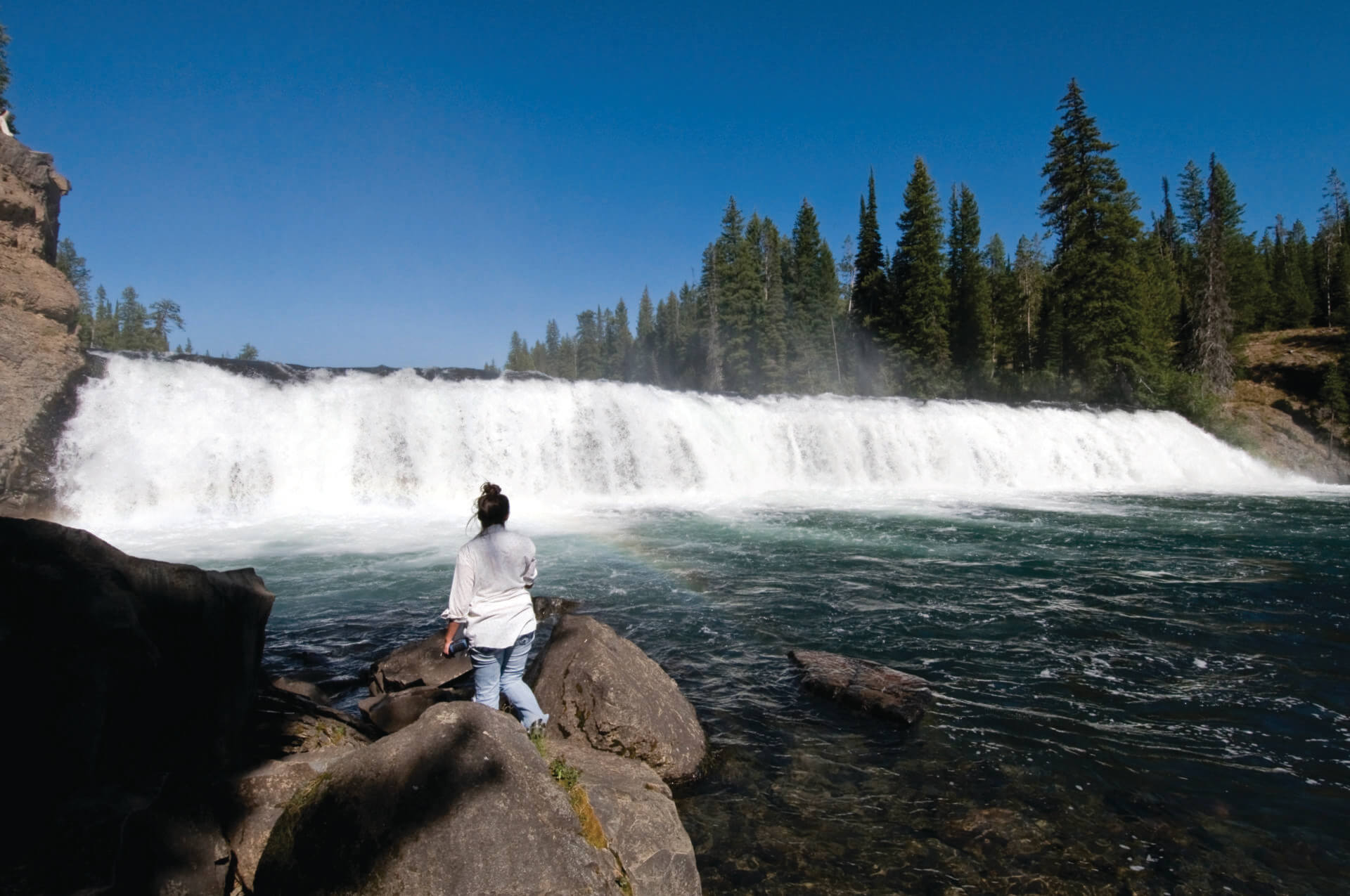Read The
Current Issue
Chasing Waterfalls
What kind of waterfall experience are you looking for?
// By Rachel Walker
The Greater Yellowstone Ecosystem was forged by powerful forces of nature, especially water. From frothing, raging rivers to winter snow that can be measured in feet—and then melts come spring and fills the drainages—water carves its way through cliffs and forests as it flows into rivers, lakes, and, eventually, the Atlantic or Pacific Ocean. Combine that hydrologic phenomenon with the area’s dramatic geologic uplift, and you have prime conditions to create waterfalls. The GYE’s 15-plus million acres are home to several hundred.
Like snowflakes, every waterfall is different. Here are four that are very different—in looks, in ease of getting to, and in the size of crowds you’ll encounter once there.

Cliff Creek Falls
Day hike to a waterfall in the national forest.
What you’ll see: These secluded falls in the Wyoming Range plummet more than 200 feet through an hourglass-like formation. Expect meadows exploding with wildflowers and secluded campsites. Views of surrounding mountain ranges abound, and the scene is purely Western: creek crossings, rugged rocks, sharp peaks, and signs of wildlife. Find bear claw scratches on aspen trees and look for coyote, elk, deer, and perhaps even wolf scat along the trail. These are backcountry falls, which often means fewer people and less crowding.
Get there: In the Bridger-Teton National Forest, this waterfall is a six-mile hike up 1,300 vertical feet and across several creeks. It starts at the Cliff Creek Trailhead. To get to the trailhead, head south on Highway 189/US 89 from the town of Jackson to Hoback Junction. At the roundabout, take the second exit and proceed east on US 189/191 for 14 miles. Turn right on Cliff Creek Road/Forest Service (FS) Road 30530. Continue for 6.6 miles and then turn right onto FS Road 30565.
Also in the area: A long hike and a day at the falls works up the appetite. Buffalo Bills Food Truck (wyobuffalobills.com) in Hoback Junction exists to solve that problem. Open daily from “11:30ish to 8” (per the website), the food truck serves Wyoming-size portions of burgers, quesadillas, tacos, vegetarian options, and more.

Union Falls
Backpack to a remote waterfall in Yellowstone.
What you’ll see: If weeping willows could transform themselves into water, they would look like Union Falls. At 250 feet, this stunning fan-type waterfall is among the tallest in Yellowstone National Park. In the park’s lush Bechler Region, which receives the highest amount of the park’s rainfall, Union Falls is just below the convergence of two rivers. (FYI: The Bechler region isn’t only lush with water, but also bears. Do not travel in this area without bear spray.)
Get there: A trek to Union falls is a really long day hike (32 miles), or a great opportunity to camp in Yellowstone’s backcountry (permits required). The hike, which includes multiple stream crossings and climbs about 600 feet, starts at the Cascade Creek Trailhead at the western end of Grassy Lake Reservoir off Grassy Lake Road just south of the southern entrance to Yellowstone.
Also in the area: Refresh and replenish at nearby Flagg Ranch, where log-cabin-style Sheffields Restaurant serves savory grilled meats, fish, and vegetable dishes, and the Sheffields Saloon has local beers on tap as well as a wide range of spirits. Stay the night at one of Flagg Ranch’s cozy cabins or Western lodge, or pitch a tent in the developed campground (reservations required).

Hidden Falls
Hike one or five miles to a cascade in Grand Teton National Park.
What you’ll see: These falls earn their name because they’re tucked into trees on the western shore of Jenny Lake in Grand Teton National Park. The falls tumble down a tiered natural slide for 100 feet and then gush down to the lake. Marvel at the rapid movement and frothing waters, and, because Hidden Falls are among the easiest to access in the park, expect fellow visitors.
Get there: This popular cascade—it’s the only waterfall in GTNP that you can hike to the base of—is a 4.9 mile (round-trip) hike on the Jenny Lake Loop Trail. The trail starts at South Jenny Lake, one of the busiest places in GTNP. Cut four miles (!) off the hike by taking Jenny Lake Boating’s shuttle across the lake. This runs every 10 to 15 minutes from late May through late September. $20 for adults, $12 for ages 2 to 11, and $17 for ages 62 and older.
Also in the area: No trip to Grand Teton National Park is complete without a stop at Dornans in Moose. Evelyn Middleton Dornan homesteaded here in 1922, and her family has since established (and still runs) several businesses, including a chuckwagon, a pizza and pasta restaurant with a rooftop deck and stunning Teton views (read more on pg. 76), and a deli.

Cave Falls
A drive-to waterfall in Yellowstone.
What you’ll see: Some waterfalls are tall; few are as wide as Cave Falls—about 250 feet. For perspective, that’s about as wide as a 20-story building is tall. Although Cave Falls are short (about 20 feet tall), they are mighty. You can hear their roar before you see them.
Get there: You can drive right to Cave Falls, although not from any of Yellowstone’s most popular areas like Old Faithful or Mammoth Terraces. Cave Falls is in the tiny part of Yellowstone in Idaho. From Ashton, Idaho, take State Highway 47 east to E 1400 N/Cave Falls Road. After five miles of pavement, the road turns to dirt and ends 12 miles later at the Cave Falls parking lot.
Also in the area: Camp in the Cave Falls Campground along Fall River, about two miles south of the falls in the Caribou-Targhee National Forest. This remote but developed campground has RV and designated tent sites, supreme fishing, and unimpeded views of the water. Cave Falls also has excellent fishing in the pools at the waterfall’s base. JH




